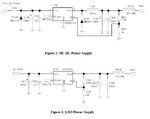Tuppe
Member level 2
Hello! I'm designing SIM908 based Car GSM module, in which I need 12V to 4V PSU. The device in 99% in sleep mode in minimal current consumption and GPS only available on-demand.
I've been stuck in this problem for few days, but I don't have the experience to decide surely.
I have 2 choices listed in the datasheet:
1. Linear MIC29302 Regulator
2. DC-DC LM2596

I already have MIC29302 linear supply with SIM900 and I'm able to get 2,5mA current consumption and the regulator doesn't heat at all. Is DC-DC really necessary? This consumption peaks to unknown range(my multimeter can't pick it up) when RF transmission bursts, so I don't really know what is happening during that period. I'd imagine that full GPS tracker needs DC-DC, but my appliance is mostly sleeping. Do you think full DC-DC worth the hassle, costs and size in my application?
DC-DC is recommended in the datasheet for +12V, but I have no test gear(not even oscilloscope) to measure the noise so it's risky play. How can I reassure that I do not interfere with the RF module?
My options currently:
1. Shielded inductor
2. SMD Ferrite bead
3. EMI cage for PSU. Are these available in general purpose uses? I can't find any.
4. 4 Layer PCB with GND planes top and bottom.
Are these all measures mandatory for proper resoults? Could I get away with 1 and 2?
I plan to mount antennas directly to the module, if that makes any difference.
Thank you very much for reading!
I've been stuck in this problem for few days, but I don't have the experience to decide surely.
I have 2 choices listed in the datasheet:
1. Linear MIC29302 Regulator
2. DC-DC LM2596

I already have MIC29302 linear supply with SIM900 and I'm able to get 2,5mA current consumption and the regulator doesn't heat at all. Is DC-DC really necessary? This consumption peaks to unknown range(my multimeter can't pick it up) when RF transmission bursts, so I don't really know what is happening during that period. I'd imagine that full GPS tracker needs DC-DC, but my appliance is mostly sleeping. Do you think full DC-DC worth the hassle, costs and size in my application?
DC-DC is recommended in the datasheet for +12V, but I have no test gear(not even oscilloscope) to measure the noise so it's risky play. How can I reassure that I do not interfere with the RF module?
My options currently:
1. Shielded inductor

2. SMD Ferrite bead
3. EMI cage for PSU. Are these available in general purpose uses? I can't find any.
4. 4 Layer PCB with GND planes top and bottom.
Are these all measures mandatory for proper resoults? Could I get away with 1 and 2?
I plan to mount antennas directly to the module, if that makes any difference.
Thank you very much for reading!
